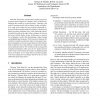Free Online Productivity Tools
i2Speak
i2Symbol
i2OCR
iTex2Img
iWeb2Print
iWeb2Shot
i2Type
iPdf2Split
iPdf2Merge
i2Bopomofo
i2Arabic
i2Style
i2Image
i2PDF
iLatex2Rtf
Sci2ools
103
Voted
VR
2000
IEEE
2000
IEEE
Enhancing Fish Tank VR
Fish tank VR systems provide head coupled perspective projected stereo images on a display device of limited dimensions that resides at a fixed location. Therefore, fish tank VR systems provide only a limited virtual workspace. As a result, such systems are less suited for displaying virtual worlds that extend beyond the available workspace and depth perception problems arise when displaying objects (virtually) located on the edge of the workspace in between the viewer and the display screen. In this paper we present two techniques to reduce this disadvantage: cadre viewing and amplified head rotations. The first aims to eliminate the problems in depth perception for objects with negative parallax touching the screen surround. Subjective observations from an informal user study indicate a reduction of confusion in depth perception. The second provides a transparent navigation technique to allow users to view larger portions of the virtual world without the need for an additional i...
| Added | 01 Aug 2010 |
| Updated | 01 Aug 2010 |
| Type | Conference |
| Year | 2000 |
| Where | VR |
| Authors | Jurriaan D. Mulder, Robert van Liere |
Comments (0)

